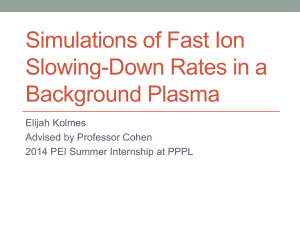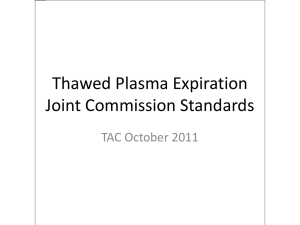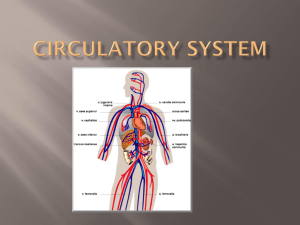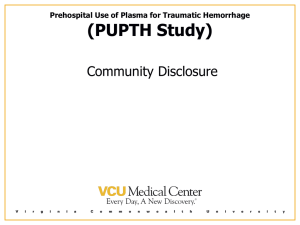Diagnostics
advertisement
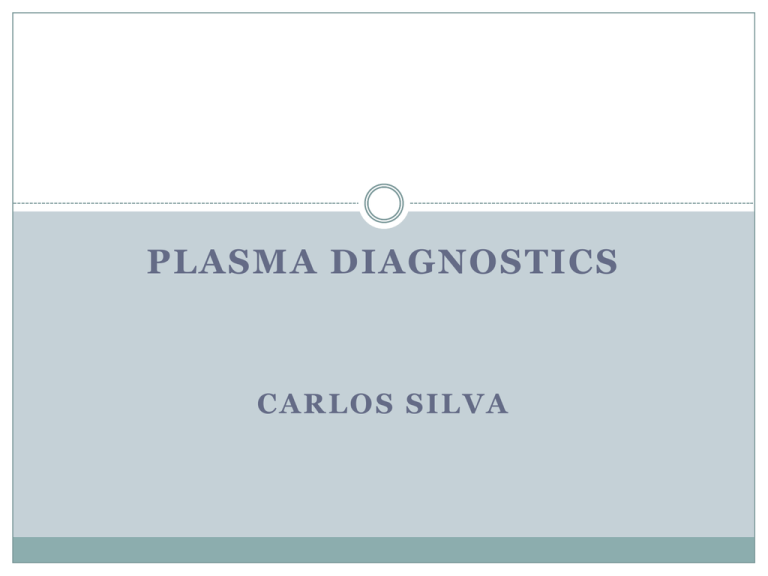
PLASMA DIAGNOSTICS CARLOS SILVA Basic concepts The physical quantities are measured with instruments. The instrument should measure always the same value if they were perfectly accurate. In reality the instruments are not perfectly accurate, so the measure differs from the real value of the physical quantity . Measurement is the activity of comparing a number with a predefined pattern, involving the existence of measurement units. These units are essentially arbitrary; i.e. create and agree to use them. The basic units are the simple measurements of time, length, mass, temperature , amount of substance, electric current and light intensity. The derived units are comprised of basic units, e.g., velocity (m/s) or density (kg/m3) . By measuring is possible to express numerically qualities (quantify ) avoiding concepts like " big / small " , " strong / weak " Diagnostics Plasma diagnostics are methods, techniques whose purpose is to deduce information about the plasma from practical observations of physical processes and their effects In general we do not have access to the physical quantity and we need to use models, theories, simulations to interpret the results. Main quantities of interest: Magnetic (Current, Flux loop, B-fields, magnetic configuration) Kinetic (Electron and ion temperature and density, pressure) Plasma composition (impurities, wall interaction) What to measure Density of particles Temperature Potential, electric field, velocities, … Energy: joule (J) but often we use 1 eV = 1.6 10-19 J (energy gain by an electron in a potential difference of 1 volt) Temperature: kelvin (K) but often we use the equivalent in eV/k (Boltzmann constant) 1 eV/k = 1.6 10-19 J / 1.38 10-23 J/K = 11600 K 1 eV 11600 K Diagnostic characteristics Ideal diagnostics should provide measurement of plasma quantities Direct and independent With good spatial and time resolution. With no perturbations (by the plasma and to the plasma) Real plasma diagnostics are Often indirect (need interpretation models as there is no direct access the physical quantity). The understanding of the associated physics process is required to interpret the results Often mutually dependent (need other plasma parameters) Spatial and time resolution dependent of the measurement technique Plasma perturbation and environment noise is an issue. Complementarity of diagnostics Different techniques: Except for a few quantities each plasma parameter in general can be measured by more than one technique, often with different spatial and time resolution or with the use of different interpretation models. Compatibility of different measurements: Different diagnostics may give different values for the same parameter. Compatibility is related to the validity of the interpretation models and to the correct determination of measurement errors. Complementarity: The diagnostics operating in a plasma experimental must be seen as set of complementary techniques that operate all together to provide a reliable picture of the plasma. Diagnostic characteristics Local measurements (electrical probes): can only be used in cold plasma. Remote measurements are required for hot plasmas. Some plasma parameters are difficult to measure (plasma characterization limited) There is a large variety of plasma diagnostics (hot and cold). The choice of the appropriated diagnostic toll depends on the plasma condition and budget. Required temporal and spatial resolution depends on the plasma parameters (ex. gradients) Temporal / spatial resolution v r ( Nt ) N n0 EB (nt ) N n (nt ) e n0 Complexity of diagnostics Noisy environment poses strict requirements: electric and magnetic shielding. Careful signal grounding. Optical insulation in signal transmission sometimes necessary Accessibility: Limited accessibility to diagnostic equipment in large fusion machines Reliability: Long term survival of plasma facing components, damage by irradiation High degree of automatization of control/monitoring of diagnostic equipment and of data acquisition. Consequence: High complexity and high cost of diagnostic systems. Accuracy vs Precision Accuracy Precision Definition The degree of The degree to which closeness to an instrument will true value. repeat the same value. Measure ments: Real value may not be known Do not mix up lack of precision with plasma fluctuations High accuracy Low precision Single High accuracy High precision Multiple measurem ents are needed Low accuracy Low precision Scales: space In large fusion experiments the spatial scales vary by 6 orders of magnitude Debye length (< mm) Electron Larmor radius (< mm) Ion Larmor radius (mm) Turbulence scale (cm) Scale of the magnetic perturbations (cm) Gradients (cm – dimension of the experiment, m) Length along the magnetic field line (10-100 m) Scales: time In large fusion experiments the temporal scales vary by 12 orders of magnitude Magnetic activity (0 – 1 MHz) Particles exchange with the wall (< Hz) Current diffusion (kHz -Hz) Magnetic equilibria, confinement ( kHz -Hz) Turbulence (1-200 kHz) Ion cyclotron frequency (> 10 MHz) Electron cyclotron frequency (10 GHz) Diagnostic classification Plasma perturbation None: Spectroscopy, Magnetic probes Weak: Micro-waves, Lasers, particle beams Strong: Electric probes, particle beams Nature Electromagnetic: Electric and Magnetic probes Optics: Spectroscopy (visible, X-ray, ...), Interferometer Particles: Ion beams Plasma Diagnostic Systems Selected low temperature plasma diagnostics Diagnostic Measures Langmuir probes Plasma potential, electron temperature & density Magnetic diagnostics Plasma current, plasma waves, …. Spectroscopic Plasma composition, ion temperature & drift velocity, ……. Microwave diagnostics Plasma electron density, density profile, ….. Mass / energy analyser Identify species of ions, and measures their charge state and energy Laser diagnostics Density of various species in the plasma Selected ITER diagnostics Diagnostic Measures Magnetic diagnostics Plasma current, position, shape, waves .. Spectroscopic & neutral particle analyser systems Ion temperature, He & impurity density, .......... Neutron diagnostics Fusion power, ion temperature profile, …. Microwave diagnostics Plasma position, shape, electron density, profile, ….. Optical/IR(infra-red) systems Electron density (Line-average & profile, electron temperature profile, …. Bolometric diagnostics Total radiated power, …. Plasma-facing components & operational diagnostics Temperature of, and particle flux to First Wall, ….. Neutral beam diagnostics Various parameters DIAGNOSTICS OVERVIEW Lectures on: Electrical probes (Carlos Silva) Magnetic probes (Bernardo Carvalho) Particle beams (Artur Malaquias) Spectroscopy (Elena Tatarova) Reflectometry (M.E. Manso, MT5) Electrical probes Conductor inserted into the plasma Simplest diagnostic Data interpretation complicated as probes perturb the plasma Limited to the plasma region were the probes can survive or do not perturb plasma Allows the determination of a large variety of plasma parameters (some of them only possible with probes) Potential and particle flux depends on plasma parameters Langmuir probes I – V characteristic Magnetic measurements Essential in magnetic confinement devices Plasma current, position, geometry, instabilities Sensor fluxo magnético Signal in the sensor Signal has to be integrated (hardware or software) Magnetic measurements Magnetic probes on ISTTOK Magnetic probes Particle beams Ions: Heavy elements (Xenon): Require large mass elements and low magnetic field. Larmor radius has the dimension of the device: The aim is to collect the ions after crossing the plasma. Information from the plasma parameters at the ionization location Neutral: Light elements (Lithium): The aim is to measure the ionization radiation. Neutral elements so not limited by B. Heavy ion beam Larmor radius has the dimension of the device: the aim is to collect the ions after crossing the plasma. Information from the plasma parameters at the ionization location Lithium beams Light elements (Lithium): The aim is to measure the ionization radiation. Neutral elements so not limited by B. Plasma radiation Plasma radiation contains important information about the plasma properties. Plasma emits electromagnetic radiation due to different physics processes Complex spectra (continuum + spectral lines) from IR to X-ray Plasma radiation Bremsstrahlung: Due to electron desacelaration in the ion field, used to measured the electron temperature Cyclotronic radiation: Due to rotation in the magnetic field ce B 1/R (50 – 500 GHz) Plasma radiation Spectral lines: Discrete radiation due to electron transition between energy atomic levels From visible to X-ray Broadening Ti, Doppler shift velocity Intensity = f(ni, n0, Te) Only high-Z elements emit X-rays ( keV, E ~ 13.6Z2 eV). Spectra: mix of continuum and lines Hot plasmas: Dominated by Bremsstrahlung (10 kev, Z~1) Low temperature plasmas: Spectral lines dominate (1 – 10 eV, Z > 1) Spectral lines Bolometer Infra-red cameras Infra-red cameras Fast visible cameras Advantages: Large temporal and spatial resolution, plug-and-play Disadvantages: Expansive (100 k €), measurement not local (different average field lines, inversion necessary), difficult to extract plasma parameters Example: Photon ultima APX-RS 3,000 fps (1024 x 1024), 250,000 fps (64 x 64) Fast visible cameras Fast visible cameras Difficult to extract physical quantities. Possible to determine the speed, size and origin of the plasma structure (need the mapping of the field lines) ISTTOK Database Support for Matlab (Octave), IDL, Matematica http://baco.ipfn.ist.utl.pt/jws/DataViewer.jnlp http://metis.ipfn.ist.utl.pt/CODAC/SDAS/Access http://metis.ipfn.ist.utl.pt/CODAC/SDAS/Codes

